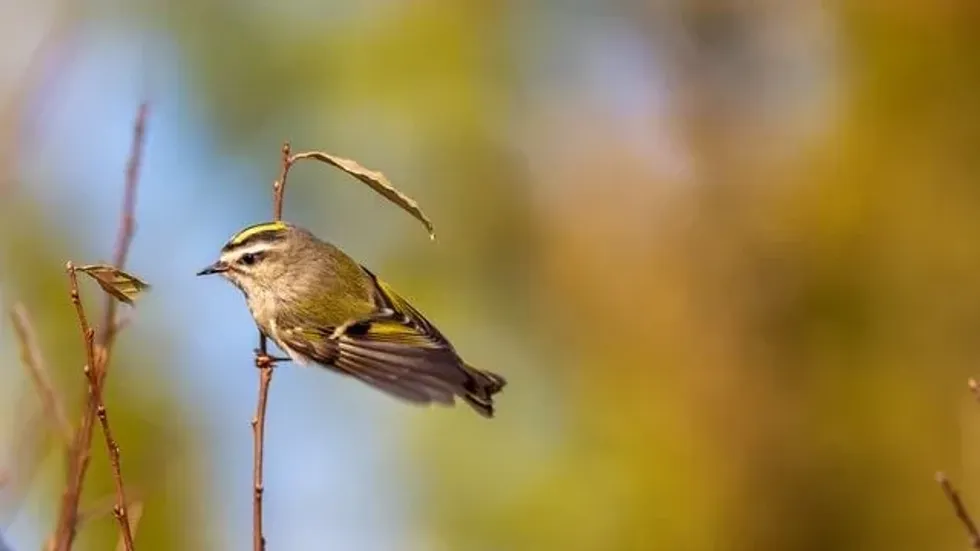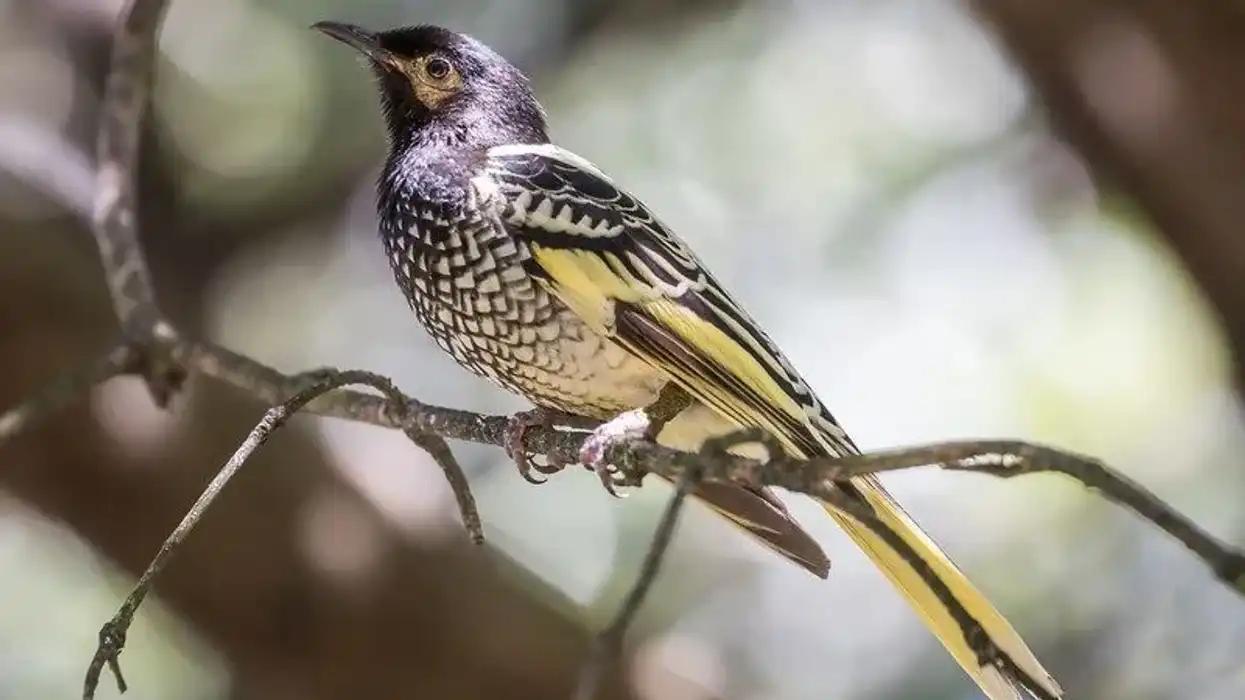The golden-crowned kinglet (Regulus satrapa) is a species of birds hailing from North America. They belong to the order Passeriformes, family Regulidae and genus Regulus. Their habitat includes coniferous forests, lowland deciduous forests, and spruce-fir forests.
Ruby-crowned kinglets are close relatives of these North American birds (Regulus satrapa). These birds make their nests in boreal forest habitats and spend their winters in various shrub and forest habitats.
These birds are found in Canada and the U.S., ranging from southwest Alaska to Newfoundland. They are more often found in the U.S. and Mexico when temperatures begin to drop.
Males are larger in size than females and they are colored and patterned differently to females so they can be recognized easily. Typically, females are less colorful than males.
These species of birds found in North America are famous for their golden-crowned kinglet song as this singing bird gives a series of piercing calls, all on a single note!
They can also be understood as nature's form of pest control. As they are fundamentally insectivores, these birds may help to control creepy-crawly populaces. This can have positive economic effects on people, particularly in the field of agribusiness, as they can help to control various creepy-crawly populaces, for example, tidy budworms.
These birds are the prey of blue jays, American red squirrels, gray jays, sharp-shinned hawks, eastern screech owls, and bobcats. These birds (Regulus satrapa) also face the wrath of lice (Ricinus frenatus, Philopterus incisus), scutate ticks (Haemaphysalis leporispalustris), hippoboscid flies (Ornithoica confluenta, Ornithoica vicina), and the protozoan parasite (Trypanosoma avium).
After reading this, do read our pyrrhuloxia and cardinal bird facts too.
Golden-Crowned Kinglet Interesting Facts
What type of animal is a golden-crowned kinglet?
This North American bird named the golden-crowned kinglet is a white-wing bird.
What class of animal does a golden-crowned kinglet belong to?
This North American species belongs to the bird class of animals (Aves).
How many golden-crowned kinglets are there in the world?
There are 130 million golden-crowned kinglet birds in the world. They are found in abundance with no major threats to their existence.
Where does a golden-crowned kinglet live?
Golden-crowned kinglets live in deciduous and coniferous forests in most of Canada, and ranging from southwest Alaska to Newfoundland. They are a typical winter occupant in the U.S. and Mexico when temperatures begin to drop.
The golden-crowned kinglet is found across Canada from Labrador to British Columbia, along the Pacific Coast to California, and in the Rocky Mountains.
They are also present in the northeastern United States, and south in the Appalachian Mountains to northern Georgia. Habitats of the golden-crowned kinglet range from the Pacific Coast to California, to British Columbia.
What is a golden-crowned kinglet's habitat?
The breeding habitat of this species of birds is spruce-fir forests. They love coniferous forests and deciduous forests as well.
Who do golden-crowned kinglets live with?
Golden-crowned kinglets live in small packs. They prefer staying with other birds and cannot survive in solitude.
How long does a golden-crowned kinglet live?
This North American species of birds has a maximum lifespan of only six years.
How do they reproduce?
This bird species is a monogamous animal group within a single breeding season but they can form new pairs each new breeding season.
They determine who they want their mates to be based on crown color, and once they pick their mates and complete the process of mating, males become responsible for taking care of their female mates and the eggs laid.
This bird (golden-crowned kinglet) of North America gains its sexual maturity at the age of one. Their reproduction system is oviparous in nature, meaning they lay eggs.
Females can produce two clutches per year and they lay 16 to 18 eggs each year. The eggs hatch within 14 to 15 days.
Females form a cup-shaped nest of greenery, lichens, fine grasses, and pine needles in a conifer tree. They make this nest which ranges from 6-50 ft (1.8-15 m) over the ground and males stay with the females until the nest is built.
What is their conservation status?
The conservation status of these birds is currently Least Concern. This bird species has extended its reach into new zones in the northeastern United States, and the populace seems stable across its reach.
Golden-Crowned Kinglet Fun Facts
What do golden-crowned kinglets look like?
The most distinguishing feature of the golden-crowned kinglet (Regulus satrapa) is its splendid colored crown feathers. Males have orange crowns, and females have yellow crowns.
A dark black band of feathers lines the crowns in both genders and adolescent males have a less pronounced or even a non-existent orange crown. Their back and wings are olive-shaded, and their wings are decorated with a white band. Their underside is a paler tan tone and these birds also have a tiny pointed dark beak.
How cute are they?
These birds are very cute and attractive in terms of their looks. The cherry on top is their colored crown and petite size!
How do they communicate?
This species of bird conveys primarily through tunes and calls. They love to vocalize like most other birds so they often make calls to communicate with their mates and with other birds. These calls sound like 'tseee', 'seeeee', or 'ti-ti-ti'. Males vocalize to ensure that everybody in the group is safe and to exercise domination.
Communication also happens through visual representations. When a male bird experiences danger, he shows his orange crown feathers and rapidly moves his tail as a warning sign. These birds can also communicate through their senses of taste and touch.
How big is a golden-crowned kinglet?
These small birds have different weights for males and females. They also can be different sizes based on the geographical location that they are from. Golden-crowned kinglets from Oregon and Washington are both between 3.1-4.42 in (78.8-112.5 mm) in length. Their wingspan is 2.05-2.20 in (52.5-56.25 mm).
How fast can a golden-crowned kinglet fly?
They predominantly travel through flight, which can be quick and erratic. They also love floating when scrounging close to the closures of branches. They also fly in backhanded ways during long-distance flights. They can fly at 30 mph (48 kph).
How much does a golden-crowned kinglet weigh?
The female weighs up to 0.01 lb (6.1 g), and the male weighs up to 0.013 lb (6.3 g).
What are the male and female names of the species?
Both male and female golden-crowned kinglets are scientifically known as R. satrapa. They do not have specific names for each gender.
What would you call a baby golden-crowned kinglet?
A baby of this North American bird species is called a juvenile golden-crowned kinglet.
What do they eat?
These birds feed on seeds, grains, nuts, fruit, insect eggs, and terrestrial non-insect arthropods.
Are they dangerous?
These birds are not dangerous to humans. However, males can be protective of the females they mate with and their juveniles. This can lead to some aggression, but they are not harmful to other creatures otherwise.
Would they make a good pet?
They cannot be kept as pets as these wild birds prefer nesting at very high altitudes.
Did you know...
The population of the golden-crowned kinglet (order: Passeriformes, family: Regulidae) dropped between 1996 and 2010 by 67%. After noticing this, the United States government decided to take strict measures to ensure the conservation of this species.
The golden-crowned kinglet's song
The tune of the golden-crowned kinglet is heard from May to July and it includes a progression of shrill 'seet' notes followed by gentler, lower-pitched babbles. The 'seet' sounds are consistent.
Where do golden-crowned kinglets nest?
A golden-crowned kinglet female works with a male and take four to six days to build her nest that is either suspended by or laying on twigs. They gather materials including leaves, spider webs, fleece, plant material, portions of creepy-crawly covers, lichens, and bark segments to achieve a well-protected and strong nest.
The finished nest can perfectly house both mates and their baby birds.
Here at Kidadl, we have carefully created lots of interesting family-friendly animal facts for everyone to discover! Learn more about some other birds and similar species, including the falcon or the brant.
You can even occupy yourself at home by drawing one on our golden-crowned kinglet coloring pages.










